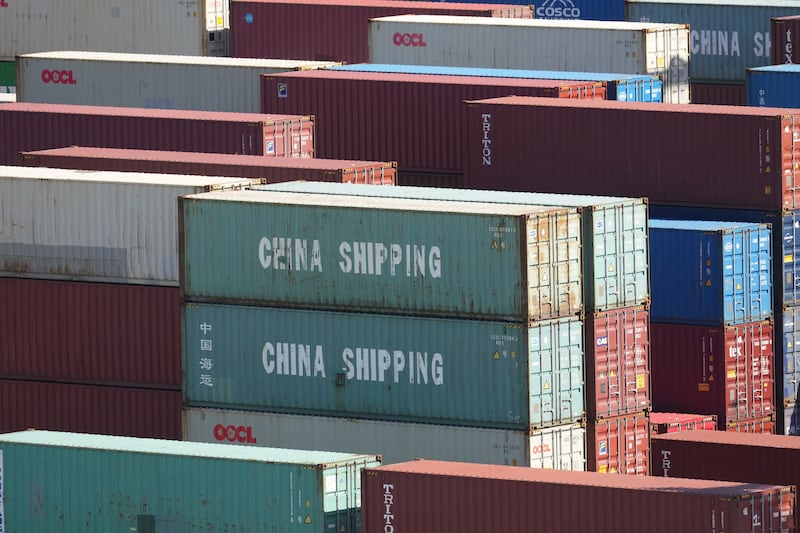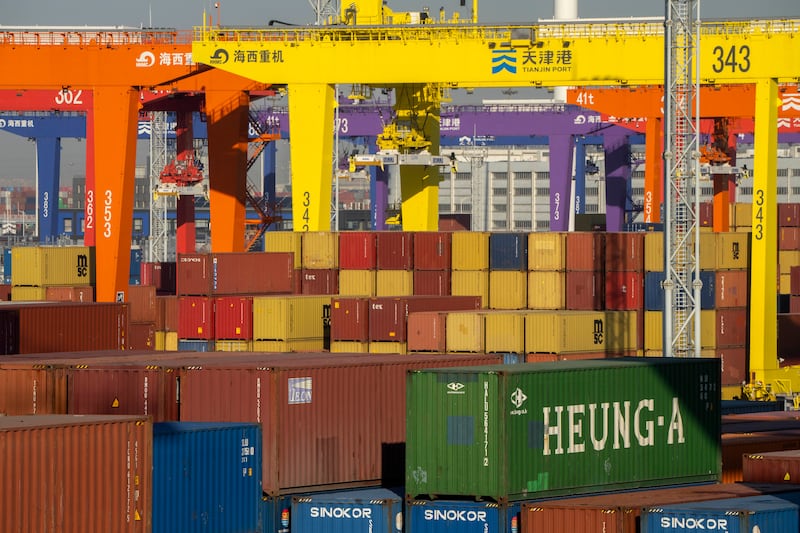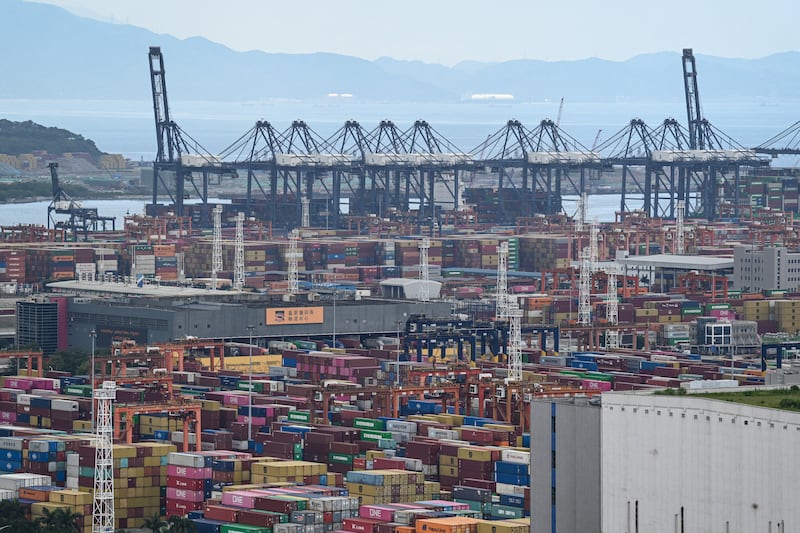Major ports and foreign trade provinces in China are showing the first signs of disruption from the ongoing tariff war between the world’s two largest economies.
Virtually no cargo ships were bound for the U.S. by Thursday from once-bustling ports in Shanghai and Guangdong, while operations at export factories in provinces that feed China’s export empire have ground to a halt, sources in the country said.
Stacks of shipping containers that failed to make the ships bound for the U.S. by the April 9 deadline are now piled high at Shanghai and Guangdong ports, local businessmen told RFA.

At warehouses, piles of goods originally intended to be exported to the U.S. lie abandoned, even as factory floors have come to a standstill in Zhejiang and Guangdong – two provinces that accounted for the largest share of China’s exports in 2024.
On Wednesday U.S. President Donald Trump announced he was raising “reciprocal tariffs” on China to 125%, which he said would be effective immediately.
The White House later clarified that the total levies on Chinese imports actually stands at 145%, after accounting for a previous 20% imposed on Beijing for fentanyl trade.
China on its part on Friday raised tariffs on U.S. imports to 125%, from 84% in retaliation against the latest tariff hike imposed by the U.S.
The tit-for-tat exchange that has played out between Washington and Beijing in the past two months was ignited when Trump imposed a 10% tariff on China on Feb. 4, citing its role in the trade in fentanyl, a deadly opioid that has become a major cause of death in America.
But when China hit back with a 15% tariff on U.S. coal and liquefied natural gas, and a 10% on crude oil, large cars, and agricultural machinery, Trump raised China tariffs further by 10% to a total 20%.

On Thursday, just a day after Trump’s 125% China tariff announcement, Shanghai’s Yangshan and Waigaoqiao terminals – where nearly half the vessels docked earlier that week had been bound for the U.S. – came to an abrupt halt, according to Beijing-based media group Caixin.com.
Only days earlier, Shanghai’s Yangshan and Waigaoqiao terminals had been teeming with activity as ships rushed to load containers in a desperate bid to complete shipments and set sail before the new tariffs kicked in, it said.
Similar scenes are playing out at the Yantian terminal in Shenzhen, Guangdong, said Qian, a Guangdong export businessman, who is currently in Shanghai and has witnessed the impact at the port of Shanghai.

Businessmen interviewed by RFA for this article requested to be identified only by their surnames for safety reasons.
According to Caixin, an employee at Chinese state-owned COSCO Shipping Holdings said many freight owners are going through customs clearance procedures, while confirming that containers that failed to make the last ships that left for the U.S. are now currently piled up in the yard.
A guidance released by the U.S. Customs and Border Protection on Tuesday said any freight that’s already on the water and coming into the U.S. ports in the coming weeks will not be subject to the tariffs.
This applies to any cargo “loaded onto a vessel at the port of loading and in transit on the final mode of transport on” or before April 5 and April 9.
Impact on China’s exports
In 2024, China exported $438.9 billion in goods to the U.S., up 2.8 percent from 2023, according to the Office of the U.S. Trade Representative. The U.S., on the other hand, exported $143.5 billion worth of goods to China that same year.
“Unless they are rolled back, the latest U.S. tariff hikes mean that China’s shipments to the U.S. will more than halve over the coming years,” Julian Evans-Pritchard, head of China economics at Capital Economics, wrote in a research note to clients.
He expects this will mean a collapse in China’s exports to the U.S. and a decline in the country’s gross domestic product by somewhere between 1.0-1.5%, depending on the extent of rerouting.
Guangdong and Zhejiang are the most affected by the tariff war, with businesses in both the science and technology industries now “stagnant”, local businessmen told RFA.
In 2024, Guangdong province exported $826 billion worth of goods, including computers, integrated circuits, video displays, and telephones, according to the online economic data platform, Observatory of Economic Complexity (OEC).
Zhejiang – which engages in export of autoparts and related accessories, semiconductors, seats, and refined petroleum – recorded $549 billion in exports in 2024, according to OEC.
“All businesses that engage in foreign trade are currently having a hard time,” said Zhang, a businessman from Qingdao, Shandong, which engages in heavy industries such as machine tools.
“If they (foreign economies) don’t perform well over there, at worst (the president) will be impeached. If ours doesn’t ‘perform’ well here, it (economy) will collapse,” he said.
Local Chinese businessmen told RFA that there is a prevailing sense of helplessness among the general public and that all walks of life are showing signs of economic depression, with empty restaurants, little consumer activity, and shuttered factories.
“Yesterday, a friend of mine took me to a restaurant for dinner on a very busy street in Shanghai. There were more than 10 waiters in the restaurant, but there were only two of us eating there,” said Qian.
“In the past, the restaurant was always full of guests upstairs and downstairs, but yesterday the upstairs was closed, and there were only two of us downstairs,” he added.
According to analysts at commodity and futures brokerage firm Huatai Futures Co., Ltd, a total of 26 voyages from China to the west and east coasts of the U.S. is expected to be canceled for weeks 16 to 19 or April 14 to May 11, with container capacity set to reduce by nearly 40%.
Edited by Tenzin Pema and Mat Pennington
